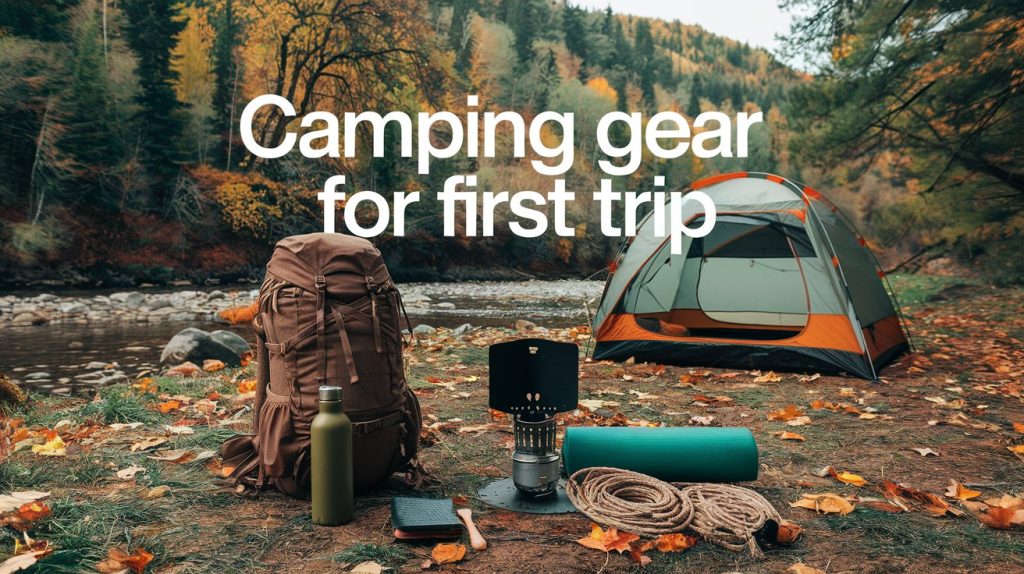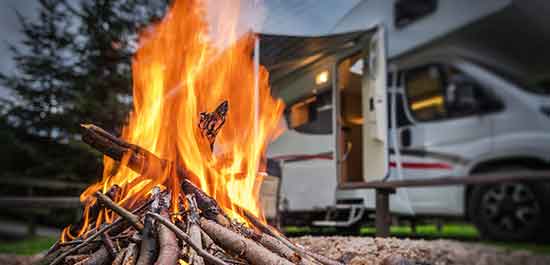Last Updated on January 25, 2025
When prepping for your first camping trip, start with the right tent—opt for lightweight options if you’re backpacking, or a more spacious model for car camping.
Pair it with a sleeping bag suited to the weather, and don’t forget a quality pad for comfort. Choose a sturdy backpack that fits well and has enough capacity for your essentials.
A reliable camp stove is key for cooking meals, along with a cooler to keep food fresh. Finally, dress in moisture-wicking layers and pack sturdy footwear for all-day comfort. Discover additional must-haves for a smooth camping experience.
Key Takeaways
- Choose a lightweight, weather-resistant tent suitable for your camping location and expected conditions for comfort and protection.
- Select a sleeping bag with an appropriate temperature rating and insulation type based on the season and your comfort needs.
- Invest in a durable backpack with a capacity of 50-65 liters, ensuring it fits properly and does not exceed 20% of your body weight when loaded.
- Pack essential cooking gear, including a reliable camp stove, cookware, and a cooler to keep food fresh during your trip.
- Include a basic first aid kit, hydration options, and appropriate layered clothing to ensure safety and comfort throughout your camping adventure.
Choosing the Right Tent
When selecting the perfect tent for your first camping trip, how do you know which one will meet your needs? Start by considering the location and weather. If rain’s in the forecast, opt for a tent designed for wet conditions.
Think about your camping style—backpacking requires lighter, more compact options, while car camping allows for larger, more comfortable tents. Additionally, consider durability and weather resistance to ensure the tent can handle unexpected elements during your trip.
Don’t forget to factor in how many people will be sleeping inside. Your budget matters too; explore renting if needed. Look for easy setup to avoid frustration. Finally, check for features like ventilation and durability.
Essential Sleeping Gear
When it comes to a good night’s sleep in the great outdoors, choosing the right sleeping bag and sleeping pad is key. You’ll want a sleeping bag that matches the season and your comfort needs, while a quality sleeping pad adds insulation and comfort against the cold ground.
Additionally, the type of sleeping bag you choose should align with expected weather conditions to ensure warmth.
Choosing Sleeping Bags
Choosing the right sleeping bag can make or break your camping experience, especially if you’re new to the great outdoors.
Begin by checking the temperature ratings; aim for a comfort rating that matches the expected weather. Down insulation is lightweight and compressible, while synthetic insulation offers better moisture resistance.
Additionally, be aware of the ISO/EN ratings, as these standardized ratings provide reliable comparisons between different brands. Consider bag shape—mummy bags are snug and warm, whereas rectangular bags provide room to stretch.
Don’t forget about size; measure your height and girth for a proper fit, ensuring you have space for extra clothing if needed.
Finally, think about seasonal use. A multi-season bag can adapt to unpredictable weather, keeping you cozy from chilly nights to warmer evenings.
Importance of Sleeping Pads
While you might think a sleeping bag is enough for a good night’s rest in the great outdoors, a sleeping pad is just as crucial for your comfort and warmth.
Sleeping pads provide cushioning from hard surfaces, allowing you to sleep without feeling every stick or stone beneath you. They add essential insulation, especially in colder weather, keeping you warm and cozy. Investing in a sleeping pad can enhance your sleep quality, reducing soreness after a long day of outdoor activities.
Plus, they prevent the compression of your sleeping bag’s down fill, enhancing its heat-trapping ability. With options like self-inflating and air pads, you can find the perfect balance between comfort and packability for your trip.
Selecting a Backpack
How can you find the perfect backpack for your first camping trip? Start by ensuring a proper fit—measuring your torso is essential, as sizes can vary.
Look for a pack with a capacity of 50-65 liters; this range strikes a balance between ample space and manageable weight. Durability is key, so choose materials that can withstand the elements.
Adjustable components, like shoulder straps and hipbelts, allow for a customized fit, enhancing comfort as you hike. Additionally, consider the importance of backpack capacity when selecting a pack to ensure it meets your needs for multi-day trips.
For longer trips, consider lightweight options. Remember, your loaded pack shouldn’t exceed 20% of your body weight, allowing for a comfortable, enjoyable adventure on the trail.
Camp Kitchen Necessities
After selecting the right backpack, it’s time to equip your camp kitchen for a successful outdoor cooking experience.
Having the right tools can make all the difference in preparing delightful meals under the stars.
Here are four camp kitchen necessities you shouldn’t forget:
- Reliable Camp Stove: Choose a stove with fuel to guarantee you can cook meals efficiently.
- Cast Iron Pan: This versatile pan can handle everything from frying to baking, whether on a stove or over a fire. Cast iron pans are also known for their durability and long-lasting nature.
- Cooler: Keep your perishable foods fresh with a good cooler and ice packs.
- Cutting Board & Sharp Knife: Essential for food prep, these tools help you slice and dice safely and effectively.
Lighting Your Campsite
Creating the perfect atmosphere at your campsite hinges on effective lighting, as the right illumination not only enhances safety but also sets the mood for your outdoor adventure.
Consider using lanterns for broad area lighting, headlamps for hands-free tasks, and flashlights for easy navigation. String lights can add a charming touch, creating an inviting ambiance.
When selecting your lights, check for high lumen output for larger areas, and choose rechargeable or solar-powered options for sustainability.
The CAMPLIGHTKIT includes options like a lantern with a maximum output of 1000 lumens, ensuring full campsite coverage. Waterproof designs guarantee durability in unpredictable weather.
Remember to position your lights wisely to minimize shadows, and use dimming features to conserve battery life. With thoughtful lighting choices, you’ll transform your campsite into a cozy retreat, perfect for evenings under the stars.
Safety and First Aid
When you head into the great outdoors, safety should always be a top priority. Packing essential first aid items like adhesive bandages, antiseptic wipes, and a reliable multi-tool can make all the difference in an emergency.
Additionally, consider having an EpiPen for known allergies, as having an EpiPen ensures you’re prepared for unexpected allergic reactions. Plus, being aware of safety precautions, such as staying on marked trails and communicating your plans, guarantees a worry-free adventure.
Essential First Aid Items
While you’re packing for your first camping trip, don’t overlook the importance of having essential first aid items on hand. These supplies can make a world of difference in case of an emergency. Here’s a quick list of crucial items you should include in your gear:
- Adhesive bandages – for minor cuts and scrapes.
- Antibacterial ointment – to prevent infections in wounds.
- Antiseptic wipes – perfect for cleaning injuries before treatment.
- Pain relief medication – like ibuprofen or aspirin, to ease discomfort. Awareness of rare injuries such as snake bites and allergic reactions is crucial for effective preparation during your camping trip.
Safety Precautions Outdoors
Packing your first aid kit is just one part of ensuring a safe and enjoyable camping experience.
Before you hit the road, check your vehicle’s condition to handle rugged terrain. Familiarize yourself with local wildlife and know how to treat bites or stings.
Arrive early to set up camp while there’s still daylight, and assess the area for hazards like poison oak or steep cliffs. Additionally, be prepared for unpredictable weather conditions by securing your tents and tarps with durable rope to prevent them from being damaged during storms.
Keep food secured to avoid attracting animals, and place your tent at least 15 feet upwind from cooking areas. Use battery-operated lights to minimize fire risks, and make sure to mark tent stakes to prevent trips.
Hydration Essentials
Staying hydrated is essential during your first camping trip, and having the right gear can make all the difference. With the right hydration essentials, you can enjoy your adventure without worry. Here are four must-have items:
- Hydration Pack: Consider the Osprey Skarab 30 for versatility or the Gregory Nano 18 for a budget-friendly option. Hydration packs are designed for on-the-go hydration with a reservoir and drinking tube for easy access.
- Water Filter: The Katadyn BeFree Gravity filter is perfect for groups, ensuring clean water with ease.
- Hydrating Foods: Pack cucumbers and melons to boost your hydration naturally.
- Backup Purification: Keep a LifeStraw Personal filter handy in case you need emergency water.
Clothing for Comfort
When you’re out in the wild, staying comfortable is key, and that starts with layering for temperature control. By packing versatile pieces, you can easily adjust to the changing weather, whether it’s a chilly morning or a warm afternoon.
Layering is crucial for temperature regulation, so ensure you have a mix of base, middle, and outer layers to adapt to different conditions. Don’t forget to choose the right footwear—your feet will thank you for sturdy boots or shoes that can handle the terrain!
Layering for Temperature Control
To enjoy your first camping trip, mastering the art of layering for temperature control is essential. Proper layering keeps you comfortable and ready for changing weather conditions.
Start with a base layer made from breathable, moisture-wicking materials like merino wool or synthetic fibers to regulate sweat and stay dry. This first layer is crucial for managing moisture and ensuring warmth.
Next, add a mid-layer, such as a fleece jacket, for insulation and humidity control. Finally, an outer layer protects against wind and rain, ensuring you stay warm and dry.
Here’s a quick checklist to help you layer effectively:
- Base Layer: T-shirts, tank tops, thermal tops, or leggings.
- Mid-Layer: Lightweight fleece or softshell jackets.
- Outer Layer: Waterproof jackets or windbreakers.
- Heated Clothing: Heated vests or gloves for extra warmth.
Choosing Appropriate Footwear
After you’ve nailed your layering strategy for temperature control, it’s time to focus on your feet. Choosing the right footwear is essential for comfort and functionality during your camping trip.
Consider the terrain and weather conditions, opting for lightweight, breathable options that offer good grip. Camp shoes are particularly useful during multi-week trips for foot relief. Here’s a quick comparison of some top camp shoes:
| Camp Shoes | Key Features | Best For |
|---|---|---|
| Bedrock Cairn Adventure Sandals | Adjustable Y strap, water-friendly | Hiking and water crossings |
| Hoka Kaha 2 Frost Moc GTX | Warm, waterproof, excellent traction | Rugged terrain, winter |
| Crocs | Cushy, waterproof, quick-drying | General camp activities |
Don’t forget to pack durable socks and guarantee a good fit to keep your adventures enjoyable!
Footwear Considerations
Choosing the right footwear for your camping trip is essential, as it can make or break your outdoor experience.
You need shoes that not only feel good but can also handle various terrains. Here are four key considerations to keep in mind:
- Durability: Select high-quality materials that withstand rough trails.
- Comfort: Look for contoured footbeds that provide arch support and shock absorption. Camp shoes are designed to provide relief from hiking boots after long hikes, enhancing overall comfort.
- Traction: Rubber soles with good tread are vital for grip on slippery surfaces.
- Adjustability: Choose footwear with adjustable straps for a personalized fit.
Additional Camping Accessories
While you might focus on the essentials like a tent and sleeping bag, don’t overlook the importance of additional camping accessories that can enhance your experience in the great outdoors.
A reliable camp stove and cookware make meal prep a breeze, while a cooler guarantees your food stays fresh. Don’t forget a portable coffee maker to kickstart your mornings. To optimize your cooler’s performance, it’s recommended to pre-chill the cooler before use.
For safety and lighting, pack a headlamp and lantern to navigate at night. Comfortable camping chairs and a table can transform your dining experience.
Bring along bug repellent and hygiene essentials to keep things pleasant. Finally, consider games and navigation tools for entertainment and direction.
Frequently Asked Questions
What Type of Camping Is Best for Beginners?
When you’re starting out, tent camping is often the best choice. It’s versatile and easy to set up, making it perfect for beginners.
You’ll find a range of tents that fit your needs, whether you’re going solo or with family. Plus, tents are portable and budget-friendly, allowing you to explore various environments.
If you prefer more comfort, consider glamping. It offers unique experiences without the hassle of setup, which can also be appealing.
How Do I Choose a Campsite?
When you choose a campsite, start by considering accessibility and location. Look for sites near hiking trails and water sources that fit your activities. Check reviews to gauge quality and guarantee the area is safe from wildlife and weather hazards.
Prioritize level ground for pitching tents and verify you have access to clean water. Don’t forget to assess the campsite’s size and privacy to enhance your overall camping experience.
What Food Is Easy to Cook While Camping?
Imagine the sun rising over the campsite, filling the air with the promise of adventure. For easy cooking, think Ziploc omelets simmering in boiling water or quick oats bubbling on your portable stove.
Try assembling walking tacos or delicious chili dogs for lunch. In the evening, savor shrimp boil foil packets or BBQ chicken sandwiches. With a bit of prep at home, you’ll transform simple ingredients into unforgettable meals under the stars.
How Can I Keep My Gear Organized?
To keep your gear organized, start by categorizing it into core and activity-specific piles. Use waterproof containers and label them for easy identification. Color-code your storage to differentiate items at a glance.
Roll clothing to save space and create an inventory list to guarantee you pack only what you need. Designate separate storage for different areas of your campsite, making everything accessible and reducing clutter during your adventures.
What Should I Do in Case of Wildlife Encounters?
If you encounter wildlife, stay calm and don’t approach the animal. Make noise to scare it away, using your voice or a whistle. Back away slowly, avoiding sudden movements.
If a bear approaches, stand your ground, make yourself look bigger, and use bear spray if necessary. Always have an evacuation plan in place and guarantee everyone knows it. Educate yourself on local wildlife before your trip to prepare effectively.
Gear Up, Head Out, and Let the Memories Begin!
Now that you’ve got the right camping gear for your first trip, picture yourself under a starlit sky, laughter echoing around the fire. With your cozy tent set up and your backpack packed just right, you’re ready to create unforgettable memories.
Each piece of gear plays its part, ensuring comfort and adventure intertwine. So grab your friends, hit the trails, and embrace the great outdoors—you’ll find that the journey is just as rewarding as the destination.



